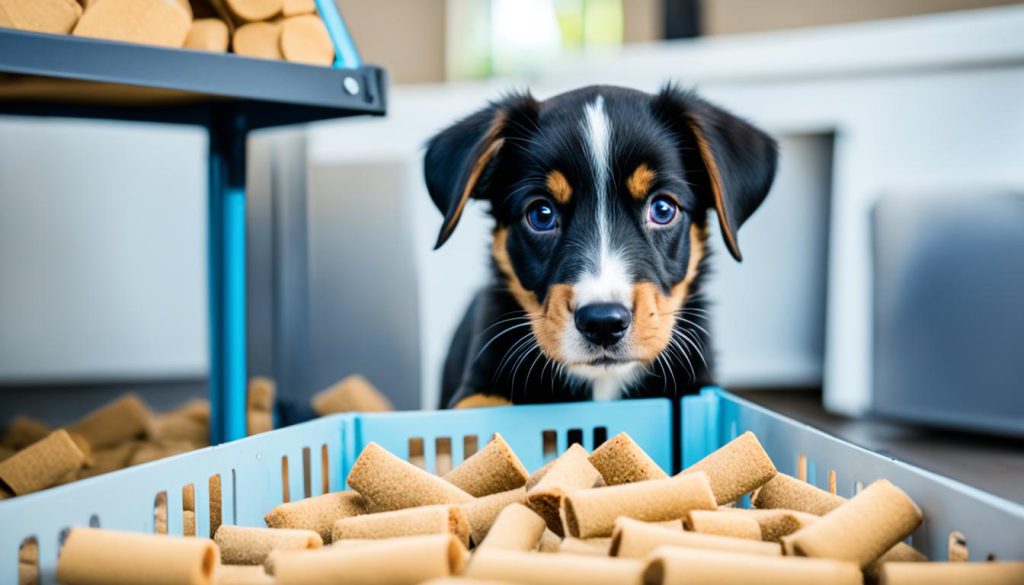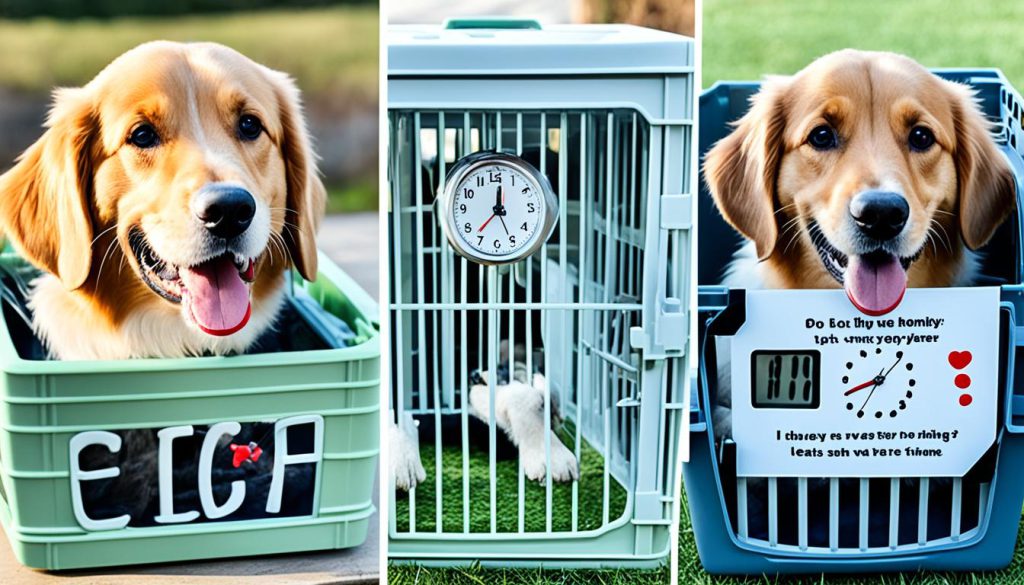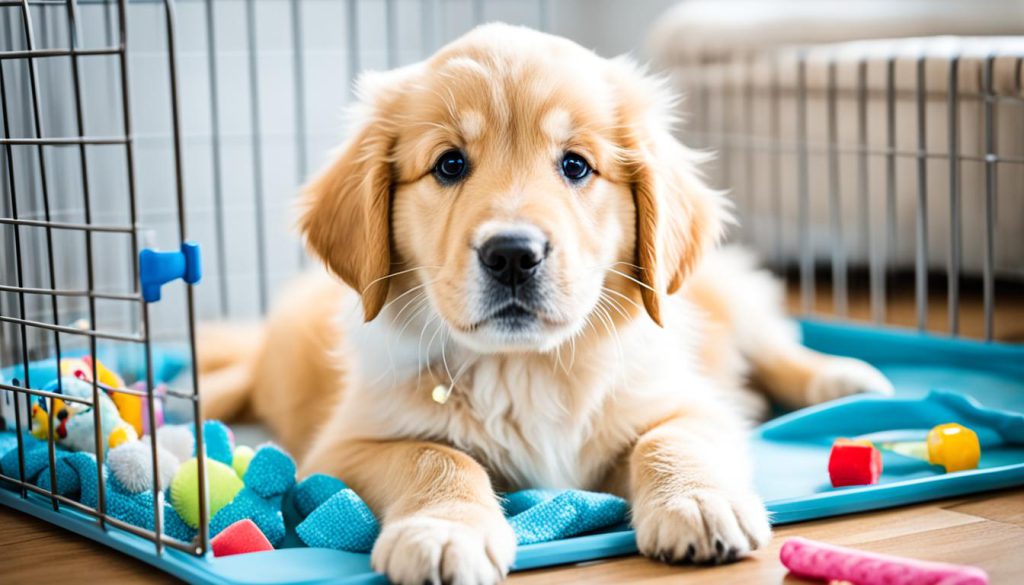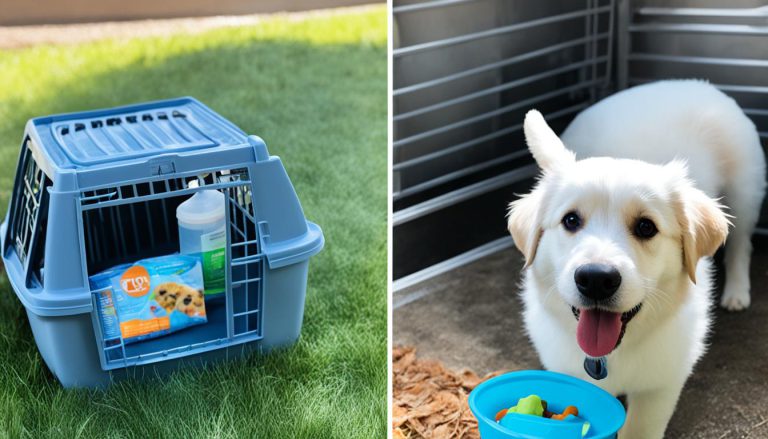Crate training is beneficial for you and your dog. But, it must be done right to avoid making your pet feel trapped or upset. The crate shouldn’t be a place for punishment. Use treats to make it a happy place. Also, balance crate time with play, exercise, and hanging out with others. This helps prevent sadness or worry.
Start crate training slowly. Let your dog get used to the crate on their own time. The crate must be big enough for them to stand and turn around. For young puppies, limit crate time to 3 or 4 hours only. They can’t hold their bladder for long.
Dogs naturally like small, cozy spaces because they are den animals. Feeding your dog near or inside the crate can make them see it as a good place. When you’re home, leave the crate open to show it’s a safe spot for your pet.
Key Takeaways
- Crate training offers many benefits but needs to be done with care to ensure the dog feels comfortable.
- A crate must be spacious enough for the dog to stand and move around easily.
- Young puppies should not be left in a crate for long due to limited bladder control.
- Create good feelings about the crate with treats and positive reinforcement.
- Slow, steady introduction of the crate to the dog’s routine is advised.
Choosing the Right Crate for Your Dog
It’s crucial to consider various factors when picking a crate. This includes the type of crate, size, and key features. Our guide will help you choose wisely.
Types of Crates
There are several kinds of dog crates. You’ll find plastic, wire, and soft dog crates. Each serves a unique purpose:
- Plastic dog crate: Also known as “flight kennels,” they are tough and great for travel.
- Wire dog crate: These offer strong construction and great airflow. They are perfect for home.
- Soft dog crate: These are lightweight and easy to fold, ideal for traveling pet owners.
Size and Growth Considerations
Choosing the right size crate is essential. Measure your dog’s height and length, then add three to four inches to each for the perfect fit. For puppies, get a crate with a removable divider. This adjusts as they grow.
| Dog Weight (lbs) | Recommended Crate Size (L x W x H) |
|---|---|
| Up to 30 | 24″ x 18″ x 21″ |
| 30 – 50 | 30″ x 24″ x 25″ |
| 50 – 90 | 36″ x 24″ x 27″ |
| Over 90 | 42″ x 28″ x 31″ |
Features to Look For
Key features are important in choosing a crate. Consider material, air flow, strength, and how well you can see your pet. Wire dog crates are often preferred for their durable, breathable design. They should have several doors for easy access. For those who travel, pick a crate approved for airlines. Make sure your dog gets used to it before you travel.
Finding the right crate is all about balance. Comfort, safety, and ease of use are key. Whether it’s a plastic, wire, or soft crate, make sure it suits your dog’s needs and your lifestyle.
Establishing a Positive Mindset for Crate Training
Creating a positive mindset is critical when it comes to crate training dogs. The first step is making the crate a happy place for your dog. Make sure the crate feels safe and inviting.

Creating a Welcoming Environment
Place the crate in a spot where your dog can see the family. This makes them feel part of the action and relaxed. Add a cozy blanket inside for comfort. Keep the door open at first to invite exploration.
Put some treats around or inside the crate to lure your dog in. Adding a favorite toy can also help. Always keep interactions with the crate positive. Serve meals in the crate to create good associations.
Using Positive Reinforcement
Positive reinforcement is key to crate training success. Setting up a crate training routine helps teach good behaviors. Feeding your dog in the crate and offering treats makes the crate a happy place.
Introduce the crate slowly to keep the experience stress-free. This method builds a healthy relationship between you and your pet. It also avoids confusion about who’s in charge, which is good for your pet’s behavior.
Now, let’s explore the benefits of crate training:
| Advantage | Description |
|---|---|
| Prevention of Destruction | Helps prevent indoor peeing/pooping and reduces home damage. |
| Reduction of Behavioral Issues | Decreases nuisance barking and reactivity by providing a safe space. |
| Establishment of Roles | Preserves the owner’s role as the decision-maker, fostering respect. |
| Support Behavioral Health | Incorporating regular crate time promotes relaxation and behavioral health. |
| Crate Training for All Dogs | Essential for safety in board & train programs; dogs are crated unless supervised. |
Building a positive association with activities like feeding and giving special treats can make the crate a happy part of your dog’s life. To succeed in crate training, keep a good schedule. Avoid too much crate time while slowly letting your dog get used to it.
Introducing Your Dog to the Crate
Teaching your dog to like the crate is key for good training. The way you first introduce the crate matters a lot. Follow these easy steps to make crate training work well for you and your puppy.
Location, Location, Location
Picking a good spot for the crate is very important. It should be where your dog feels part of the family but can still be calm. A nice place might be a quiet corner of your living room.
Step-by-Step Introduction
Begin with the crate door open and encourage your dog to check it out. Use a happy voice and treats but don’t push them inside. At first, put treats near the crate, then inside to make your dog like it more.
- Day 1: Show the crate to your dog, door open, with treats
- Day 2-3: Put treats inside so your dog goes in by themselves
- Day 4: Start giving food inside the crate, door open
- Day 5 onward: Close the door for short times after eating
Timing Your First Sessions
Getting the timing right is super important. Puppies younger than 6 months shouldn’t be in a crate for more than 3 or 4 hours. Start with short periods when you’re there, slowly making them longer.
Keep older dogs close by at night at the start. This helps them not feel left out. Always make crate time nice by adding a toy or a treat.
Follow these guidelines and pay attention to the details of crate training. This ensures a happy training experience for your puppy. For extra help, check this detailed crate training guide by the Humane Society.
Using the Crate Effectively for Training
Using a crate correctly can really help both you and your dog. It’s all about mixing in feeding times, fun toys, and slowly increasing crate time. This method makes the crate a happy place for your dog.
Feeding Your Dog in the Crate
Feeding your dog in the crate is a top tip. Check it out here. You start by putting their food bowl near the crate. Then, you move it inside bit by bit. This makes your dog comfy and less anxious with the crate.
Soon, your dog will view the crate as a cozy spot, especially at mealtime.

Using Toys and Treats
Adding toys and treats to the crate works wonders. Use toys that make them think or frozen treats they can lick. It encourages your dog to happily stay in the crate. It’s a key part of successful crate training.
Gradual Increase in Crate Time
It’s important to slowly up the time your dog spends in the crate. Start with brief sessions and stay close by to make them feel safe. Over time, you can stay away longer, as your dog gets more used to it. Follow a good schedule like this.
Remember, young puppies need more breaks. They can’t stay in the crate for too long without a bathroom break.
| Step | Duration | Action |
|---|---|---|
| 1 | 3-5 minutes | Initial introduction and feeding |
| 2 | 10-15 minutes | Short periods with toys |
| 3 | 30 minutes | Extended time with owner nearby |
| 4 | 1-2 hours | Gradual increases while stepping away |
Even with crate training, dogs need their exercise and time to play. Finding the right mix is key to happy and stress-free training.
Crate Training Puppies vs. Adult Dogs
Crate training for puppies is very different than for adult dogs. It takes into account their growing needs. Puppies under six months old should not be in a crate for more than three to four hours. They can’t hold their bladder for long. During this important time, training should include many breaks for them to go outside, especially at night. Puppies often need to go out in the middle of the night. Planning for these breaks helps avoid accidents.

Training an adult dog to use a crate depends on their previous experiences and personality. If they’ve had good experiences with crates, they might get used to it faster. But if crates are new to them, starting slowly with the right techniques is important. Being consistent and patient matters a lot, whether you’re training a young puppy or an older dog.
Choosing the right type of crate is important. There are plastic flight kennels, fabric crates on frames, and metal pens. The crate must be big enough for your dog to stand and turn around in it. For puppies, crates that can adjust in size are perfect. They grow, so the crate grows with them.
Table: Crate Training Differences Between Puppies and Adult Dogs:
| Crate Training Aspect | Puppies | Adult Dogs |
|---|---|---|
| Bladder Control | Limited, frequent breaks required | Better control, longer durations |
| Adjustment Time | Typically quicker but needs frequent supervision | Varies, can be quick if past experiences are positive |
| Crate Type | Adjustable for growth | Depends on size and comfort |
| Training Techniques | Luring with treats, frequent potty breaks | Consistency, positive reinforcement |
| Common Challenges | Night-time needs, shorter attention span | Past crate aversions, anxiety |
To successfully train your dog with a crate, understand puppies and adult dogs have different needs. Use a tailored approach, stick to routines, and use positive reinforcement. This will help your dog feel good about using the crate.
Managing Common Crate Training Issues
Managing crate training problems with your dog can be tough. Yet, knowing common issues and solutions is key for success. Let’s discuss how to tackle certain problems.
Whining and Barking
Dogs often whine and bark in their crates if they feel uneasy. This can happen if they need to go outside or want attention. Figuring out why they’re upset is the first step. If your dog keeps whining for no clear reason, don’t give in to their demands. This might make the behavior worse. Making sure your dog is exercised and has gone to the bathroom before crate time helps avoid these problems.
Overcoming Crate Aversion
Sometimes dogs don’t like their crates. When this happens, you might need to start training again from scratch. Begin by letting them check out the crate at their own pace, without forcing them. Using treats and toys helps make the crate seem like a good place. Eventually, they’ll start to like their crate more, leading to successful training. Always remember to keep up the positive vibes during this process. If you want more tips on crate training do’s and don’ts, click here.
Separation Anxiety and Crate Training
Separation anxiety can make crate training hard. It can cause a lot of barking, whining, and even destruction. To handle this, combine crate training with techniques that reduce anxiety. You might need a professional’s help. Slowly increase the time your dog spends in the crate. Make sure they stay calm. Also, set a routine that helps them know you’ll always come back. This can lower their stress and make training smoother.
Benefits of Crate Training
Many experts like veterinarians, trainers, and breeders suggest starting crate training early. They believe it greatly improves your dog’s life in many ways.
Safety and Security
Firstly, crates ensure your dog stays safe and secure. They offer dogs their own safe spot to rest. It’s especially useful in emergencies, preventing them from getting lost or hurt.
Crates also make dogs feel safe during stressful situations, like after surgery. This lets them relax peacefully. For puppies, crates are a safe place when there’s no supervision. They also comfort rescued dogs, offering them a secure spot after tough times. Making crates a happy place teaches dogs to see them as safe retreats. This reduces stress and boosts their well-being.
Housebreaking and Behavior Management
Housebreaking is easier with crate training. Puppies naturally avoid soiling their crates, simplifying the housebreaking process. Visit housebreaking with crate training for more info. Crates also prevent dogs from damaging items when alone.
Starting crate training early avoids extra stress and encourages good habits. Dogs comfy in their crates adjust better to changes. This includes having guests or welcoming a new baby home.
Traveling with Your Dog
With a crate, traveling with your dog is easier. It gives them a familiar spot during trips, making it pleasant for both pets and owners. Whether it’s a long journey or a visit to the vet, crates keep dogs calm and comfy.
Crates are essential for hunting dogs on trips or hunts, providing a secure place. They also help older pets by offering a peaceful spot for rest during travel.
| Crate Training Benefits | Details |
|---|---|
| Safety and Security | Reduces risk of getting lost or injured, provides comfort post-surgery, and creates a haven for rescued dogs. |
| Housebreaking and Behavior Management | Effective for housebreaking, prevents destructive behavior, and mitigates stress during new situations. |
| Traveling | Makes long car rides pleasant, provides a familiar space, and ensures comfort for senior and hunting dogs. |
Transitioning from Crate to Freedom
Moving your dog from a crate to roaming the house is key to their growth. It’s best to do this slowly to make sure it goes well for both your dog and you. Knowing when your dog is ready for more freedom is important for timing this change right.
Step-by-Step Transition
Changing from crate to house freedom should happen step by step. First, pick a small area, like the kitchen, to watch how your dog acts.
- Begin with short times away, slowly extending them as your dog shows they can be trusted.
- By increasing time gradually, you can avoid problems like separation anxiety and make the shift smoother.
Small dogs usually move from crate training to house freedom when they are 1-1/2 to 2 years old. Bigger dogs may take until they are 2 to 2-1/2 years old. Continue using the crate as a safe place for your dog. This keeps their good feelings towards the crate.
Signs Your Dog is Ready
Knowing when your dog is ready to roam free is crucial. Look for signs like:
- They behave well alone, with no messes or damage.
- Your dog relaxes in the crate and goes in by themselves without stress.
- If your dog stays calm in the crate longer, they might be ready for more freedom.
Watching for these signs will show you the best time to start giving your dog more freedom. Remember, being patient and consistent is key to a smooth transition for your pet.
Conclusion
Crate training helps with a dog’s safety, security, and behavior. Success comes from making the crate a happy place. This means choosing the right crate and balancing crate time with play and exercise. The guide highlighted steps like introducing the crate slowly and using treats and toys for good experiences.
Crates are mainly for short-term use, especially for young puppies. They keep puppies safe and offer a cozy spot. But, puppies less than six months old shouldn’t stay in crates for more than three hours. Training might take a few days to weeks, depending on the dog’s age and personality. This requires patience and consistent effort from the owner.
Solving crate training problems, like anxiety, is doable with the right methods and sometimes expert help. A thoughtful crate training plan will lead to a respectful and joyful bond with your dog. It ensures they’re happy and feel safe in their own space.
Source Links
- https://www.humanesociety.org/resources/crate-training-101
- https://www.akc.org/expert-advice/training/how-to-crate-train-your-dog-in-9-easy-steps/
- https://www.petmd.com/dog/general-health/crate-sizing-for-dogs
- https://www.akc.org/expert-advice/lifestyle/choose-best-crate-dog/
- http://www.sadiesrulesk9training.com/blog-posts/2019/6/29/how-to-crate-train-your-dog-and-why-you-should
- https://www.chaostocalmk9training.com/crate-training
- https://www.akc.org/expert-advice/training/why-crate-training-is-great-for-your-dog/
- https://www.preventivevet.com/dogs/everything-you-need-to-know-about-crate-training-your-puppy-or-adult-dog
- https://www.howtotrainadreamdog.com/crate-training-mistakes/
- https://www.petassure.com/new-newsletters/crate-training-part-2-the-adult-dog/
- https://zigzag.dog/en-us/blog/puppy-behavior/separation-and-sleep/when-is-puppy-ready-to-sleep-out-of-the-crate/
- https://www.downeastdesignerdoodles.com/weaning-your-dog-off-the-crate/
- https://petfrenzy.ca/dog-care/how-crate-training-works/
- https://anticruelty.org/pet-library/crate-training-your-dog

